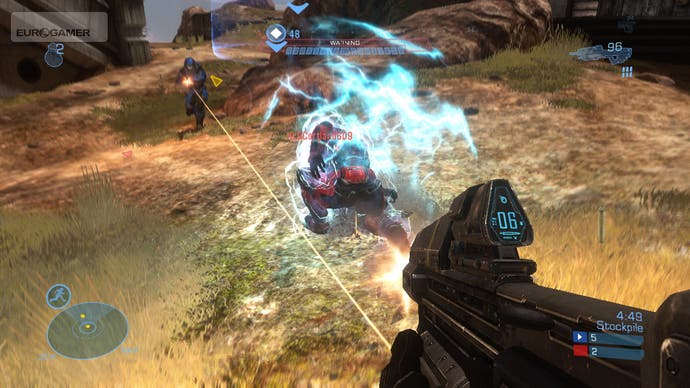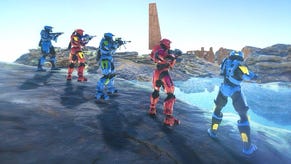Halo: Reach
How different armour abilities are making their mark.
So, the Halo: Reach multiplayer beta is now open to all - well, all the people who bought Halo 3: ODST anyway - and now that the obligatory first-day rush has finished pounding the servers into digital paste, we're starting to get a clearer picture of how this tactical new twist on a classic multiplayer formula is going to work.
It's tougher, that much is clear. Shield damage no longer translates into physical damage, so taking down other players requires headshot expertise. You can get away with a few lucky kills by blasting away, but if you're used to using a spray-and-pray technique for most of your multiplayer scalps, you're going to struggle.
It's also a game with a unique sense of balance. With pre-defined loadouts rather than rigid character classes, the different skillsets are, at first glance, not balanced at all. Elites in particular are absolute monsters; larger, faster and more powerful than the Spartans in almost every respect.
This isn't a game where each class has its own counter-agent that smoothes out its battlefield efficiency. There's no rock, paper, scissors formula to deadling with each threat, as there are abilities available here that should be game-breaking, yet somehow they're not. We'll chalk it up to Bungie's expertise in this sort of thing, offering up cool toys but restricting their use to certain maps and modes so as not to skew the playing field.

All the armour abilities are mapped to the left bumper, with a quick tap or a prolonged press producing different effects. Now they're in active service, we can see how players are making use of them.
We'll start with Jetpack because, well, that's what everybody is doing. It's a jetpack. In a Halo game. Why wouldn't you want to take it for a spin before doing anything else? It works very well, too. Control is intuitive, and it only takes a few rounds to become adept enough at flight to be dropping in on flags or snipers with lethal precision.
For the first day of beta play, however, the ground was thick with the bodies of enthusiastic n00bs who had jumped straight in, hit the bumper and flew up into the sky like dim-witted pheasants - right into the sights of a more experienced player, calmly clipping their wings and chalking up lots of lovely XP points as they tumble back to terra firma.
It's the same problem that blights planes and helicopters in Battlefield. People want to fly, and leave themselves stupidly open to attack in their eagerness to soar. Still: jetpacks. Fun.

Sprint is almost the exact opposite - an ability that barely feels like an ability at all, given that it's usually a basic requirement of the FPS genre. That's not to say it's not useful though, and as players come to grips with the way these abilities can overlap and complement each other we're starting to see the sprinters come into their own.
It's an ability usually mapped to one of the more straight forward combat classes, such as Pro or Grenadier, so for rushing an enemy position and creating a distraction it's immediately clear how to make basic use of it.
In the flag-capturing modes, it's also instinctively useful, allowing players to dart into dangerous territory or draw enemies away without losing shields. Sprint definitely seems to be working best when players operate in teams. A guy who can run fast isn't much use on his own, but pair him up with someone rocking the other abilities and it can become a vital tactical tool.
Active Camo, for example, makes for a great partner skill to someone using Sprint. While they're dashing about, attracting enemy fire, you can go all Predator, disappear behind a wobbly transparent haze and get things done. You're not completely invisible, but in the thick of the action it's easy to go undetected if you skulk about rather than stroll around in plain sight.
Once you figure out the bottlenecks in the maps, it's also very handy for lurking in dark corners with a plasma sword. There's a thin passageway in Sword Base with just enough room to loiter that will certainly become a Camo player's dream. Even if an enemy spots you, the cloaking effect is such that it generally buys you a few moments' grace while your target works out if you're friendly or not.
















